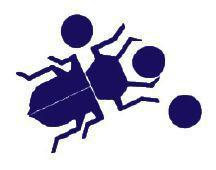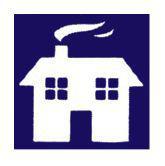SAS Urban Survival Handbook (8 page)
Read SAS Urban Survival Handbook Online
Authors: John Wiseman
Tags: #Health & Fitness, #Reference, #Survival, #Fiction, #Safety, #Self-Help, #Personal & Practical Guides, #General, #Survival Skills

Wood-borers
Groups of small holes in timber, or small clouds of powdered wood falling from them, indicate the presence of wood-boring insects (see colour pages). In most cases, it is the larvae of various beetles which do the damage, tunnelling through the wood until they emerge as adult beetles.
The main culprits in temperate climates are
woodworm
(common furniture beetles), which favour the sapwood of softwoods—which comprise most of the wooden structure of most houses—plus the sapwood of oak. They also have a taste for beech, birch, elm, mahogany and older-style plywood.
Small piles of wood dust round clean 1.5-2 mm (1/16 in) holes indicate recent activity. These are the flight holes from which the adult beetles emerge after the larvae have eaten their way around the inside of the timber for about three years. The best time to treat woodworm is in the spring, before the warm weather arrives and the beetles emerge. The pupae are usually just below the surface.
Deathwatch beetles
prefer partly decayed oak and are usually found in older buildings, producing more damage and 3 mm (1/8 in) flight holes. They are quite rare.
House longhorn beetles
are also quite rare, but represent a very large family of beetles around the world—many of which can do considerable damage. The flight holes are oval, usually about 10 × 6mm (3/8 × 1/4 in), filled with bore dust. House longhorns tend to attack the sapwood of seasoned softwoods. The larval stage can last eleven years, so by the time the flight holes appear, timbers may be ‘eaten away’ inside.
Powder post beetles
tend to inhabit timber yards and sawmills, favouring the sapwood of new hardwoods. They don’t like old wood. Their flight holes are about 1.5 mm (1/16 in) across.
Wood-boring weevils
tend to prefer decaying hard or soft wood—they are most commonly found in damp cellars and buildings close to water. Once the rot is treated the weevils tend to die out.
In sub-tropical and tropical climates,
termites
are a major problem. They look like large white ants—and are often so called. They attack almost anything that contains cellulose—wood, paper, cardboard, chipboard. They don’t live in wood—they eat it or take it back to their nest, which may be underground. Attack by termites should be treated as an emergency. Chemical and biological controls are used, but termites are very determined.
It’s common to try sheet metal at ground level to protect posts and structural timbers—but even sheet metal dampcourses don’t stop them. They can create a route through most thin substances, including metal, glass and concrete. They may even attack the sheathing of cables, causing short circuits and power failures, and make holes in piping.
The
lead cable borer
in the US favours hardwoods like oak and laurel—also called ‘short circuit’, it bores into leadlined cables. The
bamboo borer
, although it only breeds in tropical climates, may be exported to any location in bamboo furniture. It may attack wood in the home—not just bamboo—if conditions are favourable.
Carpenter ants
(mainly in the US) create galleries inside timbers, depositing excavated wood outside their nests.
Carpenter bees
bore 20 mm (3/4 in) diameter holes, which lead to large galleries which run with the grain of the wood.
Avoiding infestation
Woodworm, in particular, like old furniture—the thin plywood backs of wardrobes, all-plywood ‘utility’ furniture and basket work. Treat any secondhand or imported furniture before installing it in your home as a matter of course. Treat all timbers if there has been any evidence of attack. Treat all new wood that is brought into the house. Don’t store lots of old furniture or wood in the loft.
WOOD PRESERVATIVES/INSECTICIDES
 Protective clothing (including boots, gloves, filter mask and goggles) MUST be worn when applying fungicides, insecticides and preservatives. They—and the fumes given off by them—are toxic for up to a week after application. During this period:
Protective clothing (including boots, gloves, filter mask and goggles) MUST be worn when applying fungicides, insecticides and preservatives. They—and the fumes given off by them—are toxic for up to a week after application. During this period:
- ■
Do NOT smoke or use naked flames near chemicals or treated areas—keep a fire extinguisher nearby - ■
Turn off gas pilot lights in treated areas - ■
Turn off electricity or isolate circuits in the area by removing fuses for at least 48 hours - ■
Temporarily remove loft insulation and securely cover water tanks for at least two weeks, if treatment is in loft - ■
Protect any rubber cables close to timber to be treated with sealer (shellac)—or cover with polythene sheet - ■
If spraying, use a coarse spray, rather than a fine mist - ■
Keep area well ventilated - ■
Do NOT sleep in a treated area and try to avoid any use for at least a week after application—longer if possible - ■
Do not eat, drink or smoke during treatment - ■
Take a shower or bath immediately after finishing the work
See DIY/CRAFT HAZARDS: Protective clothing
The main object of treatment is to safeguard the main structural timbers of the house—the roof timbers and floor joists. Treatment is a hazardous process. Don’t hesitate to contact experts to deal with large infestations.
Rotting wood—fences, outbuildings and piles of timber—may harbour any number of wood pests. Some pests don’t travel very far—others will seek out certain timbers. DON’T allow a large amount of wood to rot near your house—even fungal spores may spread.
Shipping furniture around the world seems a very likely way of introducing new pests to a country. This has already happened with several of the species listed.
Termites (in sub-tropical and tropical climates) may initially make their presence known in fences and outbuildings. DON’T wait for them to discover your house. If you see evidence of attack, or large ‘white ants’, the time has come to act.
ASBESTOS
Asbestos is now considered a dangerous mineral. Inhalation of the tiny fibres (thousands would fit into a millimetre cube) may eventually lead to:
Asbestosis:
a scarring of the lung tissue, leading to restricted breathing and sometimes death.
Mesothelioma:
a form of cancer affecting the lining of the abdomen or chest. It is usually fatal and has been linked to exposure to asbestos dust.
Lung cancer:
although smoking is considered the primary cause of lung cancer, reports suggest that exposure to asbestos increases the risk considerably.
REMEMBER
Not even a small piece of asbestos, such as a simmering mat for a stove, should be thrown into the wastebin. Waste disposal carts often crunch up rubbish and this would release fibres into the air. Dampen asbestos and double-wrap in polythene bags. Consult local government health departments for instructions on safe disposal locally.
Types of asbestos
Most old asbestos looks greyish in colour, but in fact there are three main types: brown, blue and white—white being the most common. Blue and brown have most often been linked with illness and are seldom used now. To be on the safe side, treat ALL forms as extremely dangerous, with NO ‘safe’ level for exposure to dust and fibres.
Common uses for asbestos
- ◑ Oven gloves
- ◑ Old fire blankets, fire gloves
- ◑ Toasters, hairdryers, irons
- ◑ Tumbledryers
- ◑ Insulation round hot water pipes
- ◑ Wall cladding
- ◑ Ironing board iron rests
- ◑ Roofing
- ◑ Guttering, downpipes, flues
- ◑ Simmering pads
- ◑ Car brake linings and underseals
- ◑ Fire doors
- ◑ Old electrical storage heaters
- ◑ Old textured wall and ceiling coatings
- ◑ Ceiling tiles
- ◑ Flooring
What to do
Sheet asbestos in good condition under layers of paint is best left where it is. Asbestos is at its most dangerous when friable (flaky and crumbly)—as is often the case with oven door seals and pipe insulation. NEVER drill, saw, sand or scrub asbestos. ALWAYS keep an eye open for signs of wear and tear. You should NEVER attempt large-scale removal yourself. Call an expert for advice.
IF YOU MUST TACKLE SMALL-SCALE REMOVAL
- ■
Keep other people away - ■
Wear disposable mask, overalls (preferably disposable), rubber or washable boots and disposable gloves - ■
Wet asbestos - ■
Do NOT use power tools—cut slowly by hand - ■
Remove as large pieces as possible—the less it breaks up the better - ■
Put all pieces in at least two heavy-duty plastic bags and mark clearly: DANGER! ASBESTOS DUST! DO NOT INHALE! - ■
Clean up with a damp cloth and put cloth and disposable clothing in same bag before closing - ■
Wash non-disposable clothing - ■
Shower, washing all over including your hair
PUTTING THINGS RIGHT
 House repairs take time and money, quite apart from the upheaval and stress that may be caused. Try to think, during every day of major work, that—if done properly—many jobs may not need doing again in your lifetime. Bodged repairs will only lead to more work, more stress and more expenditure.
House repairs take time and money, quite apart from the upheaval and stress that may be caused. Try to think, during every day of major work, that—if done properly—many jobs may not need doing again in your lifetime. Bodged repairs will only lead to more work, more stress and more expenditure.
Outdoor maintenance may not seem as rewarding as tackling interior decoration—but it is much more important. You may find yourself redecorating very soon if you haven’t had a proper job done on a leaky roof, or had rotten wood removed and made good.
Priorities
Give priority to making the house watertight—bad weather may force this decision upon you. Whatever the weather, treat the following as urgent:
- ◑ Serious cracks in walls, rendering
- ◑ Defects in the roof
- ◑ Rising damp, wet rot, dry rot
- ◑ Problems with gutters, downpipes or external drainage
- ◑ Unsafe chimney stacks
Inside:
Do something about:
- ◑ Faulty or inadequate electrical systems
- ◑ Leaky, bodged plumbing and heating systems
- ◑ Inadequate lighting on stairs and changes of floor level
- ◑ Ventilation
- ◑ Blocked or damaged chimneys and flues
Annual inspections
Once a year, or immediately after a bad storm or very high winds, check the condition of the roof. Look for loose tiles and slates, displaced flashings where roofs abut a wall or round the base of the chimney, blocked gutters and downpipes, signs of water penetration through walls and ceilings, deteriorating external woodwork, blocked airbricks.
REMEMBER
When large-scale remedial work is undertaken it may be your chance to make major improvements to your home. Bear in mind that you are likely to need planning permission for certain types of building work.
BASIC SERVICES
Every house is different, as is every lifestyle, but most homes rely on water supplies, electricity, gas, oil, or solid fuels. Remember it is your home and you are in control. All the basic services, while making life easier or more comfortable, can also be sources of great danger.
You SHOULD know where to go in your home to turn off any or all of the supplies—both for routine maintenance and in the case of emergency. DON’T wait until the storage tank in the loft overflows and brings down a ceiling. DON’T allow someone to be asphyxiated by gas before checking that a gas appliance is correctly installed.